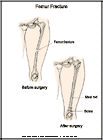
Femur Fracture
What is a femur fracture?
Your femur is your thighbone. It extends from your hip to your knee. A fracture is a crack or a break in a bone. Types of fractures include the following:
- SIMPLE - There is only one fracture line, and the bone is broken into 2 pieces.
- COMMINUTED - There is more than one fracture line, and there are more than 2 bone fragments at the fracture site.
- CLOSED - The skin in the fracture area is not broken, and the break is not exposed to the outside.
- OPEN (COMPOUND) - The skin over the fracture is broken, exposing the broken bone.
- PATHOLOGICAL - The bone has been weakened or destroyed by disease so that it breaks easily.
- STRESS - There is a hairline crack in a bone, sometimes not even visible on an x-ray, that is caused by repeated injury or stress on the bone.
How does it occur?
Femur fractures, except for stress fractures, are caused by events that involve a lot of force. Because the femur is a very large bone it takes a lot of force to cause a fracture. Examples of accidents that might break the femur are falling from a height or having a high-speed collision, such as while skiing or snowmobiling.
What are the symptoms?
Symptoms of a femur fracture include:
- severe pain
- swelling and bruising
- inability to walk
- visible deformity at the site of fracture
- the feeling that the bone in your thigh is moving.
When you break your femur, you may lose a lot of blood in the thigh. You may feel numbness, coldness, or tingling in your foot or lower leg if the blood supply to these areas is injured. If you lose a lot of blood, you may go into shock.
How is it diagnosed?
Your health care provider will review your symptoms and order x-rays of your leg. Because of the great force needed to break a femur, your provider will check to be sure there are no injuries to other areas such as your pelvis, knee, and lower leg.
How is it treated?
Most femur fractures need to be fixed in surgery. Your leg may be placed in traction in the hospital before surgery is done.
Methods used to fix a femur fracture include surgery to insert:
- steel screws
- steel plates and steel screws
- steel rods, which can be placed down the center of the shaft of the femur.
In healthy adults, casts are rarely used for femur fractures. A body cast that includes the entire injured leg and part of the uninjured leg are commonly used for femur fractures in young children.
Breaks at or near the knee joint usually require plates and screws or just the screws. Shaft fractures, as in the midthigh, are usually fixed with a rod.
You will need to use crutches for 8 to 12 weeks after surgery. Your health care provider and physical therapist will tell you whether or not you should put weight on your injured leg, which will depend on how bad the fracture is and how it has been treated.
While you are still healing after surgery, you will begin physical therapy to regain strength in your muscles and to loosen up your joints. (Muscles are usually injured in a femur fracture, and your hip and knee commonly become stiff due to the injury and surgery.)
Complete recovery may take many months, depending on how bad the fracture was and the extent of any other injuries. The break itself should heal in about 4 months. Your health care provider will take x-rays regularly to see how the bone is healing. Full recovery, however, requires the muscles and joints to heal as well. Your provider and physical therapist will assess the recovery of your muscles and joints by measuring joint mobility and the return of muscle strength, flexibility, and coordination. Your health care provider may decide to remove the plates, screws, or rods sometime after your leg has fully healed.
When can I return to my sport or activity?
Returning to your sport or activity after a femur fracture can be a long process. It may take a year before you can return to some sports. When your bone is healed and you have done some basic rehabilitation, you will begin rehab activities and exercises specific to your sport. It may take a few months to complete this recovery phase, after which you can return to your sport. It usually takes months after you return to your sport to reach your preinjury level of performance.
The following list gives some general requirements that you might be expected to meet in order to return safely to your sport:
- You have full range of motion in the injured leg compared to the uninjured leg.
- You have full strength of the injured leg compared to the uninjured leg.
- You can sprint straight ahead without pain or limping.
- You can do 45-degree cuts, first at half-speed, then at full-speed.
- You can do 20-yard figures-of-eight, first at half-speed, then at full-speed.
- You can do 10-yard figures-of-eight, first at half-speed then at full-speed.
- You can jump on both legs without pain, and you can jump on the injured leg without pain.
How can I prevent a femur fracture?
Femur fractures are usually caused by accidents that cannot be prevented. This type of fracture rarely occurs in common team sports. However, it is important to use good judgment in sports such as skiing, rock climbing, snowmobiling, and horseback riding. It is also important to have a good diet with enough calories and calcium.

